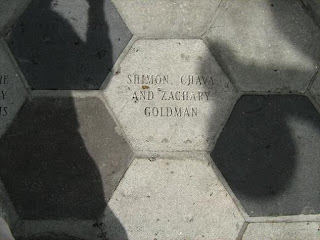I needed something to do while Rachel was lecturing at her conference, and there didn't look like there was much to do in Tampa that didn't require a chunk of money (Busch Gardens and the like) or the loss of one's brain (Hooters?). Research discovered two historical areas, Channelside and Ybor. Channelside's main attraction appeared to be restaurants, which was useless for me. So I decided to try Ybor.
At this point in time, I knew nothing about what there was to see in Ybor, why I was going, or even what it was, other than that it was a place to see. I didn't know why, or what I'd find.
I managed to find something called Ybor and followed a twisting and inconsistent path of signs to parking. I passed nothing of significance as I was driving; lots of dull suburban house and empty lots. I got a familiar sinking feeling that I was wasting my time.
I parked and asked the attendant what there was to see and he handed me a map and directed me to Ybor Centro, a block away. Ybor Centro was a movie theater, a video arcade, an ice cream stand, a Victoria's Secret store, and a Scientology center.
Wow. Time to leave?
There had to be something else here. I hoped. So I looked at the map and walked a block or two past nothing interesting to the Ybor information center and museum. I would find out what else there was and then leave.
The woman at the desk told me that there was a three dollar fee to walk around the exhibits and also the preserved building next door. And by doing so, I could learn about the history of Ybor and its cigar manufacturing.
What? I came all the way here to learn about cigars? I hate cigars! What am I doing here?
"What am I doing here?" I asked her.
She said that I will also learn about the interesting immigrant communities and the progressive industry Ybor ran. Also, how the community was a mix of Italian, Sicilian, Spanish, Cuban, and Jewish immigrants, and how they all supported each other.
...
*ding*
"Wait a minute, I said. Jewish immigrants?" There was a Jewish immigrant history in Ybor significant enough for this woman to mention it?
Yes, she went on. The Jewish immigrants to Ybor were a significant part of the immigration mix. They were Romanian, Russian, and Spanish. While the main workers in the cigar factories were Cuban, Spanish, and Italian, the Jews ran many of the local businesses.
I was starting to get interested.
"Go on," I said.
Apparently, the immigrants each had their own cultural centers which supported them from cradle to grave with health insurance, activities, and so on. Not only that, the cultures supported each other. For instance, when an Italian group went on strike, the Jewish merchants extended them credit to buy good for their family during the strike, without which they couldn't have fed themselves.
But it gets better. The father of the Cuban revolution, José Julián Martí Pérez, lived in Ybor. The cigar factory would send secret messages inside the cigars organizing the revolution. When the time was ripe for revolution, the prominent Jewish merchant Isadore Kaunitz helped arrange the funding for the Cuban revolution and helped support the Cuban families while the men went off to fight. This was because the Jews, themselves subject to discrimination and subjugation, were sympathetic to the Cuban cause. Isadore was given some sort of recognition after the revolution.
I watched the 18 minute movie in the museum, and it mentioned the Jewish immigration along with the other immigration population very respectably. While I was watching it, the museum's manager handed me a photocopied twelve page article "The Princes of Seventh Avenue: Ybor City's Jewish Merchants" from The Sunland Tribune, Vol XXVIII, 2002. In it, Yael V. Greenberg-Pritzker writes all about the history of Jews in the Ybor area, from the earliest immigrants until today.
Armed with this information, it was with a new eye that I walked down to 7th Avenue, a block from the museum, and began to see the remnants of Jewish heritage that pervade the area even today.

The original stores are gone, but along the tops of the buildings you can see the names of the original builders. Along 7th Avenue, many buildings bear the names of the original Jewish merchants from the area.

In the 1980s and 90s, these stones were added to the street by locals on various occasions. They line 7th avenue. Some bear the names of the original residents or children thereof.
And that was my unexpected find on an otherwise dreary Friday in Tampa.
Yehuda
No comments:
Post a Comment